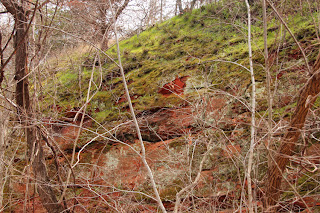The canyon is host to a great number of small animals.
These steps laid into the sides of the ravines were a great
help in walking the area. We're at that point in our lives
where we even find ourselves taking advantage of the
benches appearing occasionally along the trail.
This chimney rock is called Balancing Rock. Not too long before our visit,
some young kid decided to jump from the canyon rim down onto the top of
Balancing Rock. Once he landed, it suddenly dawned on him that he had
no place to go from there. When his companions went to the park office for
help, the staff had to call the fire department to bring in a ladder truck to
get him down.
A long flat section of canyon wall ending in another pool.
This wall is a popular place for rappelling, and numerous
cuts in the rim can be seen from where ropes have been
pulled up and down over the edge.





































